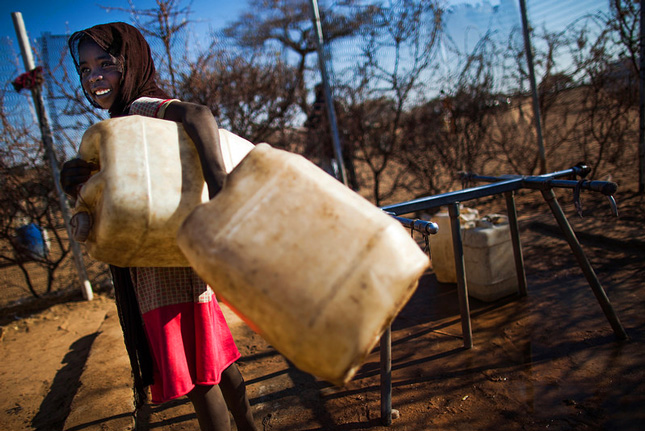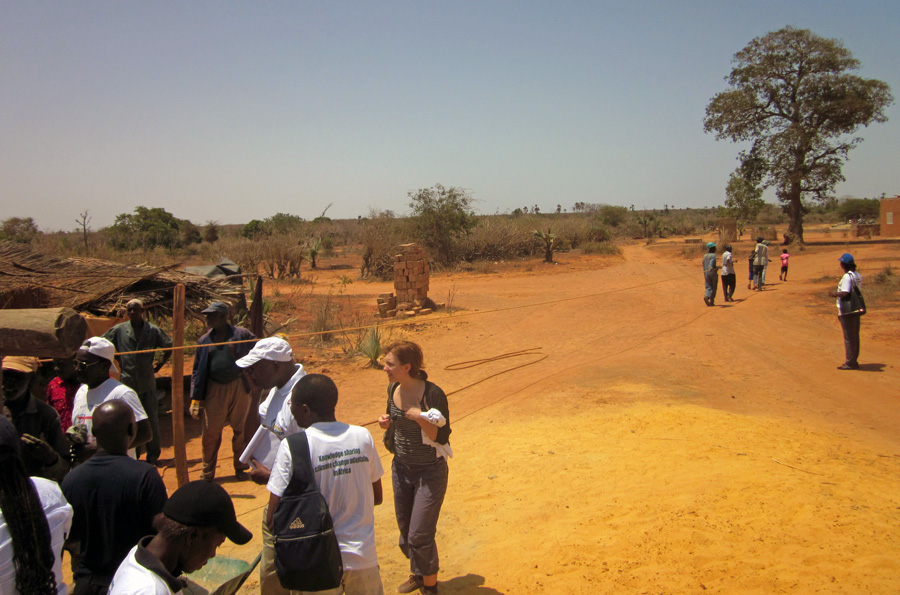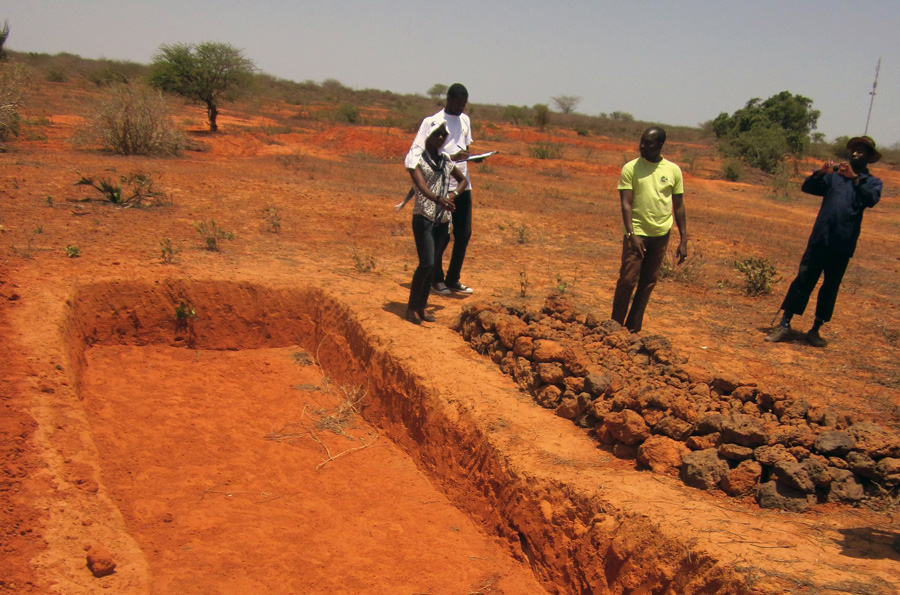-
Measurement Matters: Understanding Water Scarcity in an Increasingly Complex World
March 21, 2014 By Kathleen Mogelgaard
It was a scorching hot April afternoon in Keur Moussa, a small farming community about 60 kilometers outside Dakar, Senegal. The landscape was mostly barren and very dry, and a fine red dust settled into our clothes as we walked with community leaders to learn about their efforts to cope with a changing environment. In this part of the world, adapting to climate change is figuring out how to manage water: how to survive for long periods without it, and what to do when too much comes at unexpected times.
In this part of the world, adapting to climate change is figuring out how to manage waterSeveral men gather round a well, which, they tell us, they need to dig deeper each year. Children grab hold of a rope threaded through a pulley and start walking. They are 50 feet from the edge when a small bucket finally emerges at the top, filled with opaque, brown liquid. This is the water they filter to drink.
But Keur Moussa has other vital water needs beyond drinking, and there have been other changes besides environmental. Seventy percent of the population in Senegal is employed in agriculture, the vast majority of which is rain-fed. The rains are no longer predictable, the farmers tell us (most of them women). And when the rain does come, it is often in torrents, washing away topsoil and leaving much of the land rocky and infertile. They show us hand-made dikes, berms, and pits they have dug to trap water and soil during these downpour events, and they seem hopeful that the next harvest will be better. At the same time, total food demand is growing due to rapid population growth. From today’s roughly 13 million, Senegal is projected to grow to somewhere between 29 and 37 million people by 2050.

Kids pull up the bucket from Keur Moussa’s well 
Rainwater catchments designed to capture deluges As we celebrate World Water Day, this is a moment to consider how water is central to development and basic survival – and how growing pressures, like climate change and population growth, create even greater urgency for measuring and managing it. The residents of Keur Moussa struggle to get enough clean water to drink, and their crops suffer too. But their challenges aren’t related simply to the quantity of water available – they are also linked to quality, the kinds of demands on it, the infrastructure in place to access and store it, and the timing of its arrival as rain.
Different Flavors of Scarcity
There is not enough water in Keur Moussa, there is no doubt. But a population’s relationship with water can be measured in different ways. A look at some of the most commonly used definitions of “water scarcity” shows the complexity of challenges facing places like this:
- The “Falkenmark” Water Stress Index: Named for Swedish hydrologist Malin Falkenmark, this basic measure includes two factors: population and total freshwater resources in a given location. An area (this measure is typically reported by country) is said to be experiencing “water stress” if available freshwater is below 1,700 cubic meters per person per year; the “water scarcity” benchmark is 1,000 cubic meters per person per year or less; and “absolute water scarcity” is below 500 cubic meters per person per year. While the measure doesn’t reflect important factors like regional or seasonal variations in supply or demand, it’s a rough measure that can help flag areas where water resources may be a challenge. And by pairing it with population projections, it provides a snapshot of areas where water availability may become an acute problem in the future, as Population Action International has done.
- Criticality Ratio: This measure, also called a withdrawal-to-availability ratio, moves beyond the physical supply of water to reflect the relationship between supply and demand in a given location, measuring the proportion of annual water withdrawal to the total annual available water resources. Due to the importance of environmental flows – such as rivers and wetlands – that are essential for ecosystem function and sustained human activity, water withdrawals need to remain below certain thresholds to avoid disruption. A country is considered water scarce if withdrawals are more than 20 percent of annual renewable supply, and severely water scarce if withdrawals exceed 40 percent of supply. In cases where demands exceed these benchmarks, there is growing reliance on costly and energy-intensive desalination technology or on non-renewable “fossil” water, as has occurred in the Middle East and North Africa.
- Water Poverty Index: A much more nuanced measure of a population’s relationship with available water resources, the Water Poverty Index includes multiple indicators designed to reflect the role of income and infrastructure in water availability. The index includes measures of water quantity, quality, and variability; measures of domestic, agricultural, and industrial use; access to clean water, including time required to collect it; capacity for water management; and environmental uses of water. The Water Poverty Index provides perhaps the most comprehensive picture of a population’s relationship with water resources, and can help us better understand how changing climate conditions and population growth will alter that relationship over time. The index is most suitable for assessing conditions at the community level, and for designing local strategies for improved management. However, collecting complete data for the index can be a challenge, particularly in areas where financial and human resources are limited.
As these measures show, a lack of sufficient clean water supplies – for human needs and for environmental processes – can stem from a wide range of circumstances. Different measures have utility at different scales. For example, in understanding the scale of population pressures on water nationally or globally, the Falkenmark Water Stress Index can provide a snapshot of what the future may hold. Alternatively, if we want to more fully understand the challenges facing residents of Keur Moussa, the Water Poverty Index may be the most useful approach.
Planning for Tomorrow Today
The Sahel may be getting drier, but by how much and where exactly?The supply of freshwater globally is fixed, but demand will grow significantly. According to the most recent United Nations projections, world population is likely to increase from roughly 7.2 billion today to somewhere between 8.3 and 10.9 billion by 2050, while extreme poverty levels (thankfully) are declining. The impacts of climate change – shifting rainfall patterns, reduced snowpack, and extreme weather events – are already exacerbating water scarcity even further in many parts of the world. A recent study published in Environmental Research Letters estimated that climate change will aggravate or cause new water scarcity (using the Falkenmark Water Stress Index) for nearly 500 million people – without accounting for concurrent population growth; when growth is considered, that number could jump to an astounding five billion people.
In the face of these mounting challenges, it is increasingly important to assess baselines, measure progress, and adaptively manage our efforts to ensure water security. Understanding possibilities for the future can help us better strengthen development decisions today. The Sahel may be getting drier, but by how much and where exactly? And how will aquifer and surface water levels be affected? Could strengthened infrastructure increase access and better manage growing variability, without compromising environmental flows? These are questions that have a great deal of bearing for the people of Keur Moussa and millions of communities like it.
Kathleen Mogelgaard is a writer and analyst on population and the environment, and a consultant for the Environmental Change and Security Program.
Sources: Center for Ecology and Hydrology, Environmental Research Letters, Inter Press Service, International Food Policy Research Institute, Pacific Institute, Population Action International, The Huffington Post, U.K. Department for International Development, UN Population Division, World Bank.
Photo Credit: A girl collects water at a camp in Northern Darfur, courtesy of Albert González Farran/UN Photo; Keur Moussa images used with permission courtesy of Kathleen Mogelgaard.
Topics: adaptation, Africa, climate change, development, environment, featured, flooding, food security, Middle East, natural resources, population, poverty, Sahel, Senegal, water
 A Publication of the Stimson Center.
A Publication of the Stimson Center.





